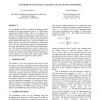Free Online Productivity Tools
i2Speak
i2Symbol
i2OCR
iTex2Img
iWeb2Print
iWeb2Shot
i2Type
iPdf2Split
iPdf2Merge
i2Bopomofo
i2Arabic
i2Style
i2Image
i2PDF
iLatex2Rtf
Sci2ools
JOS
2011
2011
The problem of the initial transient (again), or why MSER works
In a comprehensive study of methods for dealing with the problem of the initial transient, Hoad et al. (2008) determined that the MSER (White, 1997) was an efficient and effective truncation rule appropriate for automation. In this paper, we suggest that the MSER works well because it minimizes an approximation to the mean-squared error in the estimated steady-state mean. Using the example of an M/M/1 queue, we provide a clear statement of the problem in both the time and frequency domains, distinguishing between the biasing effects of initialization and autocorrelation. We also demonstrate that, as a result of autocorrelation, the objective of minimizing initialization bias is not exclusively a matter of determining the most representative initial condition. This observation further argues against the replication/deletion approach to output analysis.
| Added | 14 May 2011 |
| Updated | 14 May 2011 |
| Type | Journal |
| Year | 2011 |
| Where | JOS |
| Authors | K. P. White Jr., S. Robinson |
Comments (0)

